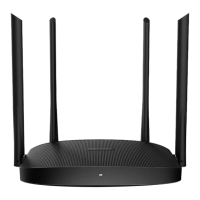WiFi Router • User Guide
71
IPv6 LAN parameter description
It specifies the type of IPv6 LAN address assignment. By default, it
is Auto.
The router generates the IPv6 address according to its LAN IPv6
address. By default, the prefix has 64 digits.
It specifies the type of IPv6 LAN prefix address assignment. By
default, it is Auto.
The router obtains a LAN prefix from the upstream device.
DHCPv6 (Dynamic Host Configuration Protocol for IPv6) is used to
assign IP addresses and prefixes to IPv6 hosts on a network. It is
the IPv6 equivalent of the DHCP for IPv4. This is also known as a
stateful autoconfiguration.
DHCPv6 Address
Assignment Method
It specifies the assignment type of DHCPv6 address for the clients
connected to the router.
Auto: DHCPv6 stateless configuration. Clients obtain their IPv6
address through Router Advertisement (Stateless Auto Address
Configuration) and other parameters are allocated by the
DHCPv6 server.
Manual: DHCPv6 stateful configuration. The DHCPv6 server
automatically assigns IPv6 addresses/prefixes and other
network configuration parameters (such as DNS server
addresses) to clients. The user needs to manually configure the
start ID and the end ID.
The configuration is required when the IPv6 DHCP type is set to
Manual.
It specifies the range of the last segment of the IPv6 address that
the DHCPv6 server assigns to the devices. Range: 1 to ffff.
It specifies the LAN IPv6 DNS configuration method.
Auto: Obtain the IPv6 DNS address from the upstream device.
Manual: Configure the IPv6 DNS address manually.
It specifies the fixed IPv6 DNS address provided by your ISP here.
If your ISP only provides one DNS server address, you can leave the
Secondary IPv6 DNS blank.

